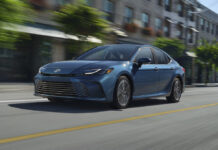Last year, the Toyota RAV4 sold 407,594 units, while the Nissan Rogue sold 403,465 units. These figures are enough to make these two vehicles the best-selling crossovers in the US. What do you do when you have the two best-selling crossovers on the market? You do a buyer’s guide comparison, of course. In the video above, Andre and Michael go through everything you need to know in TFLcar’s Toyota RAV4 vs Nissan Rogue Buyer’s Guide.

Gas Powertrains
Much like their sales numbers, the Rogue and RAV4 have very comparable powertrain options. Both utilize a 2.5L four cylinder engine. The Toyota’s makes 176 horsepower and 172 lb-ft of torque. Power is sent to the front wheels through a 6-speed automatic transmission, although AWD is optional. In front wheel drive, this setup will net you 23 MPG city and 30 MPG highway.

Hybrid Powertrains
The Toyota’s hybrid system involves a 2.5-liter naturally aspirated four-cylinder paired with an electric motor. That combination sends 194 horsepower and 152 lb-ft of torque through a CVT to all four wheels. This setup is good for 34 MPG city and 30 MPG highway

Nissan fitted the Rogue with a 2.0-liter, naturally aspirated four-cylinder, paired to an electric motor. Total power output is 176 horsepower and 205 lb-ft of torque. The car sends power to the front or all four wheels through Nissan’s bread and butter CVT. The hybrid powertrain boosts fuel economy to 33 City/35 Highway MPG.
Andre and Michael delve much deeper into the intricacies of these vehicles’ trim levels. To see how they stack up, and to learn more about the different pricing options and trim levels, be sure to watch the whole video!
Be sure to stay tuned to TFLcar and TFLnow for more helpful buyer’s guide reviews like this one.

























